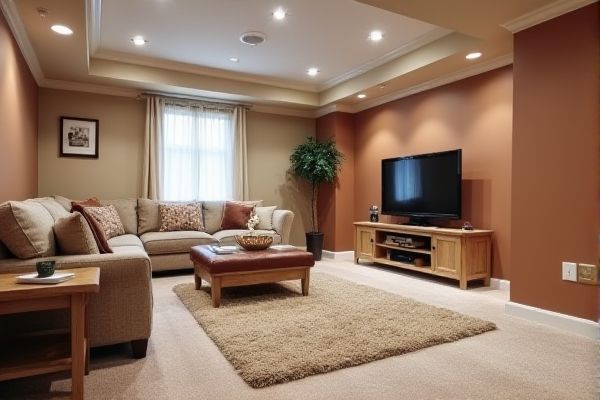
Choosing between an area rug and wall-to-wall carpet for your basement depends on factors like budget, maintenance, and style preferences. Explore our detailed guide to discover which flooring option best suits your basement's needs and enhances your living space.
Table of Comparison
| Feature | Area Rug | Wall-to-Wall Carpet |
|---|---|---|
| Installation | Simple, no fixed installation | Professional installation required |
| Coverage | Partial, customizable area coverage | Full floor coverage |
| Maintenance | Easy to clean and move | Requires regular vacuuming and deep cleaning |
| Durability | Varies by material, less durable for heavy traffic | Generally durable, suitable for high traffic |
| Moisture Resistance | Can be removed if moisture issues arise | Prone to mold and mildew if basement is damp |
| Cost | Lower upfront cost | Higher upfront and installation costs |
| Comfort | Soft and cushioned depending on rug pad | Consistent cushioning throughout basement floor |
| Aesthetic Flexibility | Easy to change style or colors | Permanent style until replaced |
Introduction: Area Rugs vs. Wall-to-Wall Carpet for Basements
Area rugs offer versatility and easy maintenance for basement floors, allowing you to highlight specific zones while adding texture and warmth. Wall-to-wall carpeting provides comprehensive coverage, enhancing insulation and soundproofing in damp basement environments. Your choice depends on balancing durability, moisture resistance, and comfort preferences for an optimized basement design.
Moisture Resistance: Which Flooring Handles Basement Dampness Better?
Area rugs offer better moisture resistance in basements prone to dampness by allowing easy removal and cleaning, preventing mold and mildew buildup on the floor. Wall-to-wall carpet tends to trap moisture beneath the surface, increasing the risk of mold growth and damage to subflooring in humid environments. Choosing moisture-resistant materials like synthetic fibers for area rugs enhances durability and helps maintain a healthier basement environment.
Installation Process: Area Rugs Compared to Wall-to-Wall Carpet
Area rugs require minimal installation, often only needing placement and occasional securing to prevent slipping, making them a flexible option for basement flooring. Wall-to-wall carpet installation involves professional measuring, padding, stretching, and securing to ensure a seamless, durable surface that covers the entire basement floor. The complexity and permanence of wall-to-wall carpet installation contrast with the ease and adaptability of area rug placement, affecting both time and cost considerations.
Comfort and Insulation: Warmth Underfoot in Basement Spaces
Area rugs provide targeted warmth and comfort underfoot by adding an extra layer of insulation in basement spaces, enhancing cozy zones where people gather. Wall-to-wall carpets offer consistent insulation across the entire basement floor, reducing cold drafts and maintaining stable temperatures throughout the room. Both options improve thermal comfort, but wall-to-wall carpet typically delivers superior overall warmth by covering the entire surface area.
Style and Design Flexibility: Customizing Your Basement Look
Area rugs offer greater style and design flexibility for your basement by allowing you to easily change colors, patterns, and textures to match evolving tastes or seasonal decor. Wall-to-wall carpets provide a seamless, uniform look but limit your customization options since the entire space is covered in one material and color. Choosing area rugs lets you experiment with layering and defining different zones within your basement, enhancing both aesthetics and functionality.
Maintenance and Cleaning Requirements for Each Option
Area rugs in basements offer easier maintenance since they can be removed for thorough cleaning and spot-treated individually, reducing the risk of mold and mildew growth in damp environments. Wall-to-wall carpets demand consistent vacuuming and professional deep cleaning to prevent dirt accumulation and potential moisture damage, which requires more effort due to their fixed installation. Your choice impacts maintenance frequency and cleaning methods, especially considering basement humidity levels.
Durability and Lifespan in Basement Environments
Area rugs typically offer greater durability in basement environments due to their ability to be cleaned, replaced, and moved, reducing wear from moisture and mold. Wall-to-wall carpets often suffer from shorter lifespans in basements because prolonged exposure to humidity can cause mold growth and fiber deterioration. Choosing an area rug allows you to protect your flooring investment while maintaining a fresh, long-lasting appearance in your basement space.
Cost Comparison: Budgeting for Area Rugs vs. Wall-to-Wall Carpet
Area rugs typically offer a lower upfront cost compared to wall-to-wall carpet, making them a budget-friendly option for basement flooring. Wall-to-wall carpeting involves higher material and installation expenses, especially in larger basement areas where padding and labor add to the total cost. Your choice between the two depends on balancing initial budget constraints with long-term durability and maintenance considerations.
Sound Absorption and Noise Reduction for Basement Flooring
Area rugs offer targeted sound absorption and noise reduction by cushioning footsteps and softening sounds in specific zones of a basement, while wall-to-wall carpeting provides comprehensive noise dampening across the entire space. Wall-to-wall carpet, especially when paired with a high-density padding, significantly reduces airborne and impact noise, making it ideal for basements prone to echo and sound transmission. Area rugs, though less extensive, allow for customizable noise control and can be layered for enhanced sound performance in localized high-traffic or noisy areas.
Verdict: Making the Right Choice for Your Basement Flooring Needs
Choosing between an area rug and wall-to-wall carpet for your basement depends on factors like moisture control, comfort, and maintenance. Wall-to-wall carpet offers full coverage and warmth but may be prone to mold in damp areas, while area rugs provide flexibility, easier cleaning, and allow you to protect a durable floor beneath. Your decision should align with your basement's humidity levels and usage to ensure durable, cozy flooring that matches your lifestyle.
 homyna.com
homyna.com